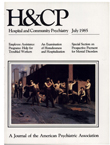A Plan for Prospective Payment for Inpatient Psychiatric Care
Abstract
Taken as a whole, this plan offers a relatively simple pricing scheme that creates some incentives for economizing behavior. With respect to the setting of the rate and the determination of covered costs, we expect that the same rules will be followed for psychiatrid care as for medical care: the prospective payment rate will be a complex combination of the hospital's cost base, the regional rate, and the national rate. In addition, we would recommend that the rate be the same for all diagnoses unless there is consistent evidence that the average per diem cost for the first four days of treatment differs significantly by diagnosis.
Our proposal is driven by a concern over the possible undesirable effects of incentives created by a case-based prospective payment system using diagnosis-related groups. It is our view that heterogeneity within DRGs, coupled with the inability to identify patients above and below the group average, may lead to responses that harm the sickest patients. Recent studies offer empirical evidence that suggests decreases in the quality of care when inpatient resources are stringently regulated (3,7). While it is clear that there is room for important cost savings in inpatient mental health care, it is undesirable to attain these savings through a system that shifts costs onto the sickest portion of the patient population. It is unlikely that, in the long run, a case-based system such as DRGs is the best system for psychiatric patients.
Access content
To read the fulltext, please use one of the options below to sign in or purchase access.- Personal login
- Institutional Login
- Sign in via OpenAthens
- Register for access
-
Please login/register if you wish to pair your device and check access availability.
Not a subscriber?
PsychiatryOnline subscription options offer access to the DSM-5 library, books, journals, CME, and patient resources. This all-in-one virtual library provides psychiatrists and mental health professionals with key resources for diagnosis, treatment, research, and professional development.
Need more help? PsychiatryOnline Customer Service may be reached by emailing [email protected] or by calling 800-368-5777 (in the U.S.) or 703-907-7322 (outside the U.S.).



